Heitjans P., Karger J. (Eds.). Diffusion in Condensed Matter: Methods, Materials, Models
Подождите немного. Документ загружается.


21 Concept of Mismatch and Relaxation 873
the “long-time regime” that corresponds to the impedance frequency range,
below 10 MHz. This is important, because experimental conductivities used
for scaling purposes have almost exclusively been measured below 10 MHz.
From (21.22) it is evident that in the long-time regime W
scaled
is a unique
decaying function of t
scaled
. Correspondingly, σ(ω)/σ(∞) also exhibits scal-
ing, and the “onset angular frequency” may be chosen to be ω
O
from (21.19).
In the frequent case of K =2,wehave
ω
O
=
A
B
exp(−B)forK =2. (21.23)
This “onset angular frequency” ω
O
has been marked in Fig. 21.10.
The inverse onset angular frequency, 1/ω
O
, plays the role of a crossover
time at which macroscopic random diffusion is attained. Likewise, a crossover
distance,
O
, may be defined by
O
=(6D/ω
O
)
1/2
. The example of RbAg
4
I
5
is particularly clear-cut. In this solid electrolyte, the density of mobile ions
is high, the value of K is found to be 2 as in Fig. 21.10, and the elementary
hopping distance, x
0
, is known. From the conductivity spectra of RbAg
4
I
5
,
to be discussed in Sect. 21.7, we find that within experimental error there is
no difference between x
0
and the distance
O
, after which random diffusion
prevails. This means that an ion, after a hop from one site to another, loses its
memory of the previous site as soon as it succeeds in stabilising its position
at the new one. Therefore, within experimental error, ω
O
can be identified
with the “random hopping rate” or “rate of successful hops” of the ions, Γ :
ω
O
≈ Γ =6D/x
2
0
. (21.24)
Equation (21.24) is expected to hold not only in the particular case of
RbAg
4
I
5
but in many other ionic materials as well.
As only a fraction Γ/Γ
0
= W (∞)=exp(−B) of all hops are successful,
we find that the elementary hopping rate should be
Γ
0
= Γ · exp(B) ≈ ω
O
exp(B)=
A
B
for K =2. (21.25)
As illustrated in Fig. 21.10, the position of A/B ≈ Γ
0
is situated between
ω
O
≈ Γ and ω
E
= AB on the frequency scale.
In most crystalline and glassy electrolytes, the dc conductivity, σ
dc
=
σ(∞)exp(−B) is found to obey the Arrhenius law. This means that σ
dc
· T
is proportional to exp(−E
dc
/k
B
T ), where E
dc
is the activation energy. In
those cases, where high-frequency conductivities, σ(∞), have also been de-
termined, they turn out to be Arrhenius activated as well, cf. Sect. 21.2.
Conductivity spectra of this kind are easily reproduced by the CMR, with
A and B depending on temperature in a known and simple fashion, and a
complete set of isothermal conductivity spectra at different temperatures is
readily constructed, as shown in Fig. 21.11. According to (21.24), the onset
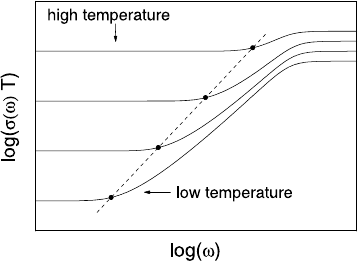
874 Klaus Funke, Cornelia Cramer, and Dirk Wilmer
Fig. 21.11. Sketch of a set
of frequency-dependent conduc-
tivity isotherms as obtained from
the CMR for the case where dc
conductivity and high-frequency
conductivity both follow the Ar-
rhenius law. The value of the pa-
rameter K is again 2.
angular frequency is expected to be proportional to the coefficient of self-
diffusion and, because of the Nernst-Einstein relation, also proportional to
the product of dc conductivity and temperature. In Fig. 21.11, the onset of
the dispersion at different temperatures is, therefore, marked by a straight
line with a slope of one. This kind of scaling, with ω
O
∝ σ(0) · T ,issome-
times called “Summerfield scaling” [18] and has already been mentioned in
Sect. 21.2.
Figure 21.11 also shows that shifting individual conductivity spectra along
the line with slope one will result in a superposition of their low-frequency
sections. This procedure was applied in Fig. 21.6, producing one experimental
master curve and, likewise, one model master curve. The same procedure
has proved successful for many glassy and crystalline electrolytes. Further
examples are glassy B
2
O
3
· 0.56 Li
2
O · 0.45 LiBr, cf. Fig. 21.12, and glassy
0.3Li
2
O · 0.7B
2
O
3
, cf. Fig. 21.18 in Sect. 21.9.
Experimentally, materials usually do not display noticeable variations
in the shapes of their low-frequency conductivities as the temperature is
changed. In the CMR, this corresponds to a fixed value of the parameter K.
Recently, changes in shape have, however, been observed in the temperature-
dependent conductivity spectra of the mixed alkali glass 0.3[x Li
2
O · (1 −
x)Na
2
O] · 0.7B
2
O
3
[23].
21.6 Physical Concept of the CMR
The concept of mismatch and relaxation builds on the jump relaxation
model [32,33], the central idea being unchanged. Each mobile ion is assumed
to have vacant sites in its immediate neighbourhood, while other mobile ions
are present in its further surroundings, very much like the ion cloud in Debye-
H¨uckel theory. Due to their mutual repulsive interaction, the ions tend to stay
at some distance from each other. Each ion experiences a time-dependent ef-
fective potential which consists in part of the static potential provided by
the immobile crystalline or glassy network and in part of a time-dependent
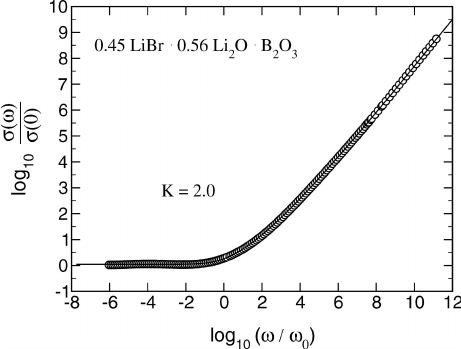
21 Concept of Mismatch and Relaxation 875
Fig. 21.12. Scaled representation of experimental and model conductivities (circles
and solid line, respectively) for B
2
O
3
·0.56 Li
2
O ·0.45 LiBr glass. The value of K is
again 2. For more details on this particular system, see [23].
cage-effect potential provided by its mobile neighbours. Suppose the ion per-
forms a hop to a neighbouring site. As a consequence, mismatch will usually
be created between its own position and the momentary arrangement of its
mobile neighbours. There are two possible ways for the system to reduce the
mismatch. Either the neighbours rearrange or the “central” ion hops back
into its previous site. This explains the existence of forward-backward corre-
lations of successive hops. Consequently, the mean square displacement ex-
hibits a “subdiffusive” behaviour, cf. Fig. 21.7 (d), and dispersion is observed
in frequency-dependent ionic conductivities.
Suppose mismatch is created by a hop of a mobile ion at time t =0.
Then the mismatch function g(t), for t>0, has the meaning of a normalised
distance between the actual position of the ion and the position at which
it would be optimally relaxed with respect to the momentary arrangement
of its mobile neighbours. The function g(t) varies with time from g(0) = 1
to g(∞) = 0, describing the way mismatch decays because the neighbouring
ions rearrange, while the “central” ion is supposed to stay at its position. The
negative time derivative, −˙g(t), is thus the rate of mismatch relaxation on
the “many-particle route”. On the other hand, −
˙
W (t)/W (t) is interpreted
as the rate of mismatch relaxation on the “single-particle route”, with the
ion hopping backwards. Here, the factor 1/W (t) is required, since we focus
on those cases where the ion has not yet moved backwards at time t.The
central assumption of the CMR is then expressed by (21.12), i.e., the rates of
relaxation on the single- and many-particle routes are assumed to be propor-
tional to each other at all times. In other words, the tendency for the central
876 Klaus Funke, Cornelia Cramer, and Dirk Wilmer
ion to hop backwards is assumed to be proportional to the tendency of its
neighbours to rearrange.
Up to this point, the CMR and its predecessor, the jump relaxation model,
are identical. The CMR differs from the jump relaxation model by inclusion
of (21.11). In this equation, we consider the rate of decay of g(t), −˙g(t).
Here it is important to realise that g(t) plays the role of a normalised dipole
moment. Its dipole field is the driving force felt by the neighbouring mobile
ions, inducing their rearrangement and, as a consequence, the concomitant
decay of g(t) itself. As the rearrangement of the surrounding “ion cloud”
proceeds, the central dipole will become increasingly shielded. This means
that two effects occur simultaneously. One is the decay of g(t) with time. The
other is the shrinking of the effective volume of the dipole field. In other words,
the effective number of mobile neighbours available for the relaxation becomes
time-dependent. It is evident that this is an extremely complicated dynamic
process, much more complicated than Debye-H¨uckel theory. Any attempt
to grasp its essence in a simple equation must contain approximations. For
deriving a suitable equation we start from the relation,
−˙g(t) ∝ g(t) ∗v(0)v(t)·#(t) . (21.26)
Here, the rate of decay of g(t)attimet is expected to be proportional to
the convolution, denoted by “∗”, of the driving force and the velocity auto-
correlation function of the neighbouring mobile ions. No distinction is made
between the velocity autocorrelation function of the central ion and that of
its mobile neighbours. Furthermore, the rate of decay of g(t) is expected to
be also proportional to a function #(t) denoting the time-dependent effective
number of mobile neighbours available for the relaxation.
It is now easy to show numerically that g(t) varies with time much more
slowly than v(0)v(t) does. As a consequence, the convolution is well approx-
imated by the product of g(
t)andthetimeintegralofv(0)v(t),whichis
proportional to W (t). Indeed, functions g(t)andW (t) obtained by use of the
approximation are found to satisfy the exact equation (with the convolution)
perfectly [12]. Equation (21.26) thus becomes
−˙g(t) ∝ g(t) W (t) · #(t) . (21.27)
While #(t) is certainly a decaying function of time, its shape is not easily
determined from simple model considerations. Therefore, in a more empirical
approach, we have tried to determine its shape by comparing experimental
spectra, σ(ν), and model spectra obtained from (21.10), (21.12), and (21.27)
using functions #(t) with different shapes. As a result, good agreement be-
tween model spectra and experimental spectra is obtained, if #(t) is assumed
to decay as g(t) or slightly faster. This results in (21.11) with K =2orK>2.
Interestingly, the value of K appears to be related to the overall num-
ber density of mobile ions. If the number density is high, then K ≈ 2gives
21 Concept of Mismatch and Relaxation 877
excellent results in most cases, implying that #(t) should be roughly pro-
portional to g(t). Smaller number densities are reflected by a more gradual
increase of σ(ν) in the vicinity of the onset angular frequency, ω
O
. According
to Fig. 21.9, this corresponds to a larger value of K implying a more rapid
decay of #(t), cf. (21.27). A tentative simple explanation of this effect may be
as follows. Let us assume the unshielded effective volume of the dipole field
and the number of mobile ions contained in it do, indeed, decay with time in
the same fashion as g(t) does. Then, if the overall number density of mobile
ions is large, the difference between the number of mobile ions contained in
that volume and the number #(t) will not be significant, since it is only one
(the “central” ion). However, if the number density becomes smaller, then
this difference becomes increasingly significant. The function #(t) will then
decay faster than g(t), and the effect will be the more pronounced, the smaller
the number density is.
At this point, we should like to compare the model concept of the CMR
with approaches that focus on the effects of static disordered energy land-
scapes on the ion dynamics, see e.g. [39,44]. In either treatment, each mobile
ion encounters varying potentials in the course of time. In a static energy
landscape, this happens as the ion explores larger and larger parts of its
neighbourhood. In the CMR, however, this happens locally, as the potential
is considered time-dependent itself. Therefore, the characteristic length
O
after which a mobile ion loses memory of a previous site and starts to diffuse
at random will necessarily be larger in models with static energy landscapes
than it is in the CMR. Here it is important to note that, in agreement with
the CMR approach, we find
O
= x
0
from the data available for rubidium
silver iodide, see Sects. 21.5 and 21.7.
21.7 Complete Conductivity Spectra of Solid Ion
Conductors
The vast majority of measurements of frequency-dependent conductivities of
solid ion conductors have been performed in the impedance frequency regime,
below 10 MHz. There are only few examples where measurements have been
extended into the radio, microwave and far-infrared frequency ranges. Of
course, measurement of such “complete” conductivity spectra is a prereq-
uisite for detecting the high-frequency plateau. Nevertheless, the detection
of the high-frequency plateau often poses severe experimental problems, in
particular in the case of glassy electrolytes, where it is usually swamped by
the vibrational contributions to the conductivity, cf. Sect. 21.2 and [45]. In a
few cases, however, the variation of the vibrational far-infrared conductivity
with frequency is so clear-cut that attempts to remove it appear justified.
An example is the glassy electrolyte silver thio germanate, of composition
0.5Ag
2
S · 0.5GeS
2
, where conductivity spectra have been taken continuously
up to infrared frequencies [46]. In this case it has been possible to prove that,
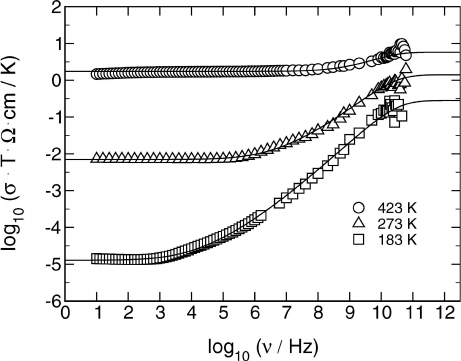
878 Klaus Funke, Cornelia Cramer, and Dirk Wilmer
Fig. 21.13. Conductivity spectra of 0.5Ag
2
S · 0.5GeS
2
glass, after removal of
vibrational contributions. The solid lines result from the CMR. As in Fig. 21.11, the
values of A(T )andB(T ) have been chosen such that both dc and hf conductivity
are Arrhenius activated. The value of K is 2.3.
within the limits of error, the low-frequency flank of the vibrational conduc-
tivity is exactly proportional to frequency squared [23]. In Fig. 21.13 we show
a set of non-vibrational conductivity spectra of glassy 0.5Ag
2
S · 0.5GeS
2
which have been obtained from the original ones by removing the vibrational
component. Although the uncertainty introduced by this procedure is consid-
erable at microwave frequencies above 10 GHz, it is evident that the spectra
of Fig. 21.13 closely resemble the model spectra of Fig. 21.11. The solid lines
included in Fig. 21.13 are CMR model spectra. Both A/B and exp(−B)are
thermally activated, the activation energies of A/B and σ(∞) ·T being iden-
tical. The best choice for the value of K is 2.3.
While the spectra of Fig. 21.13 suffer from the scatter of the data in
the microwave regime, the separation of the vibrational and non-vibrational
contributions to σ(ν) is less problematic in the case of crystalline rubidium
silver iodide, RbAg
4
I
5
, see Fig. 21.14.
RbAg
4
I
5
is a prominent member of the class of optimised silver ion con-
ductors with structurally disordered silver sublattices [47–49]. High-frequency
conductivity spectra of RbAg
4
I
5
extending up to infrared frequencies have
been published in [7,10,50]. In the microwave regime and below, the conduc-
tivity is dominated by the translational motion of the silver ions via tetrahe-
dral sites. Slow vibrations of the silver ions within their flat potentials have
been shown to be responsible for a maximum in σ(ν) observed in the far
infrared, at about 0.5 THz [50]. Conductivity maxima beyond 1 THz are due
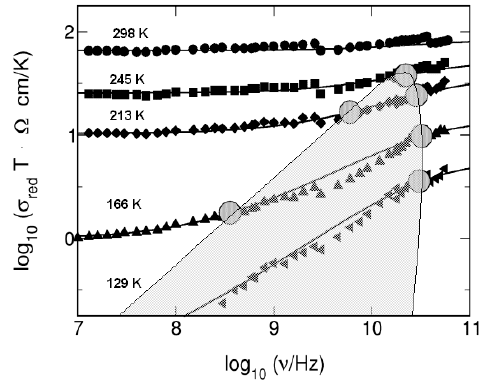
21 Concept of Mismatch and Relaxation 879
Fig. 21.14. Radio and microwave conductivities of the crystalline fast ion conduc-
tor RbAg
4
I
5
at different temperatures. The notation σ
red
indicates that vibrational
contributions to the conductivity have been removed. The solid lines result from
the CMR, with K = 2, the shaded area marks the dispersive regime. For details,
see text.
to the excitation of transverse optical phonons (cf. Fig. 21.2 for the case of
Na-β
-alumina).
The non-vibrational radio and microwave conductivity isotherms of Fig.
21.14 have been obtained from the experimental spectra by removing the
low-frequency flank of the slow vibrational contribution. At millimetre-wave
frequencies, they gradually approach their high-frequency plateaux. Again,
the product σ(∞) ·T is thermally activated, the activation energy now being
E
hf
=0.053 eV ± 0.005 eV. As noted earlier, this value is identical with the
potential barrier between adjacent tetrahedral sites in RbAg
4
I
5
as derived
from a probability density contour map for the silver ions [50]. This identity
is not surprising, since elementary hops are registered individually in the
high-frequency limit.
In Fig. 21.14, CMR model spectra are presented along with the experimen-
tal ones. The values of the parameter A are found to be exactly proportional
to σ(∞), while the best choice for K is 2.0. For each dispersive spectrum, the
onset of the frequency dependence is marked in the figure at ν
O
= ω
O
/(2π),
while its end is marked at ν
E
= ω
E
/(2π). In Fig. 21.14, the onset frequencies
ν
O
lie on a straight line with a slope of one, signifying the validity of the Sum-
merfield scaling on the low-frequency side of the dispersion. As noted earlier,
the values of ω
O
(T )=(A(T )/B(T )) exp(−B(T )) and those of the random
hopping rate, Γ (T ), of the mobile silver ions are found to be identical within
the experimental limits of error:

880 Klaus Funke, Cornelia Cramer, and Dirk Wilmer
ω
O
(T ) ≈ Γ (T ) . (21.28)
To determine Γ (T ), we have used the Nernst-Einstein relation,
Γ (T ) ≈
6σ(0)k
B
T
N
V
e
2
x
2
0
, (21.29)
where N
V
and e denote the number density of the silver ions and the elemen-
tary charge, respectively. The Haven ratio has not been included in (21.29) as
it is close to one [43]. As a consequence of (21.28), the ratio A(T )/B(T )hasto
be interpreted as the elementary hopping rate, Γ
0
(T ), cf. Sect. 21.5. Equation
(21.28) also implies that the time when random diffusion is attained corre-
sponds to a root mean square displacement of about one elementary hopping
distance.
In Fig. 21.14, the marks for ν
O
and ν
E
are on the edge of a shaded area.
Within this area the spectra display dispersion, while they become flat out-
side. On the frequency scale, the width of the shaded area is found to shrink
as the temperature is increased, until a particular point is attained at its top,
resembling a critical point and signifying the end of the dispersive regime. We
thus observe, for the first time in a solid ion conductor, a smooth transition
from a non-random hopping at lower temperatures to a random hopping at
higher temperatures. In fact, at 298 K the “ion cloud” appears to relax al-
most instantaneously after each hop of the “central ion”, leaving no energetic
advantage for a correlated backward hop and no memory of the previously
occupied site.
For W (∞)=exp(−B) we observe a gradual transition from a thermally
activated low-temperature behaviour to its high-temperature value of one.
Because of the relation σ(0) = exp(−B) ·σ(∞), this has the following impli-
cation. In an Arrhenius plot of the dc conductivity, there is a slight, gradual
change of slope as σ(0) approaches σ(∞) with increasing temperature. In
fact, this kind of non-Arrhenius behaviour appears to be characteristic of
a number of fast ion conductors, both crystalline and glassy. Examples in-
clude Na-β
-alumina [51,52], argyrodite (Ag
7
GeSe
5
I) [53], and glasses of the
system AgI − Ag
2
S − B
2
S
3
− SiS
2
[54].
21.8 Ion Dynamics in a Fragile Supercooled Melt
Comparing the dynamics of the mobile ions in glassy and crystalline elec-
trolytes on the one hand and in fragile supercooled ionic melts such as
0.6KNO
3
· 0.4Ca(NO
3
)
2
[11] and LiCl · 7H
2
O [12] on the other, one finds
surprising similarities as well as characteristic differences. Both are outlined
in this section. Considering the fragile melt LiCl · 7H
2
O, we show that the
CMR is, indeed, applicable to this system [42].
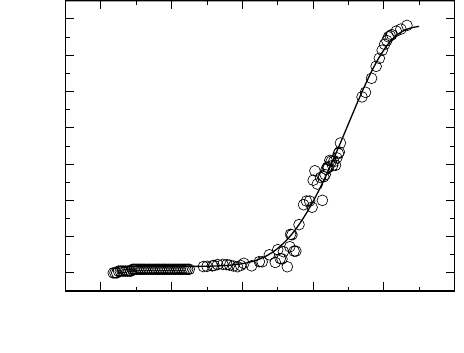
21 Concept of Mismatch and Relaxation 881
4 6 8 10 12 1
4
log
10
(ν/Hz)
-1.4
-1.2
-1
-0.8
-0.6
-0.4
-0.2
0
log
10
(σ
.
Ω
.
cm)
Fig. 21.15. Non-vibrational conductivity spectrum of the fragile supercooled ionic
melt LiCl · 7H
2
O at 253 K. The solid line is a CMR model spectrum, with K =2.
In the case of supercooled LiCl · 7H
2
O, careful removal of the low-
frequency part of the vibrational contribution to the conductivity results
in non-vibrational conductivity spectra as the one presented in Fig. 21.15. At
frequencies around 1 THz, the spectrum of Fig. 21.15 is seen to level off and
to approach its high-frequency plateau. In the figure, a CMR model spectrum
is included for comparison. Here, the numerical value of K used for modelling
has again been chosen to be 2.0 [42]. The same value of K has also been used
for fitting four other σ(ν) isotherms, and the entire set of CMR model spectra
thus obtained is presented in Fig. 21.16. Interestingly, the high-frequency con-
ductivities of Fig. 21.16 turn out to follow the Arrhenius law, with a thermal
activation energy of 0.08 eV± 0.005 eV for σ(∞) · T [12].
The observation of a thermally activated high-frequency conductivity in
a melt impacts strongly on the assessment of model approaches for the ion
dynamics. Evidently, the melt behaves solid-like, if the time window is not
larger than a fraction of a picosecond. In this short-time regime, one may vi-
sualise individual activated displacements of individual ions. At longer times,
however, the structure does not remain rigid. Structural relaxation sets in,
and the concept of fixed sites has to be abandoned. Nevertheless, the CMR
equations, (21.11) and (21.12), still seem to apply. Conceptually, it is now
important to separate the two routes of relaxation expressed by the two
equations. In particular, it is important to note that by definition −˙g(t)is
the rate of mismatch relaxation due to the rearrangement of the neighbours
under the virtual condition W (t) ≡ 1, i.e., without considering the backward
motion of the central ion itself. Therefore, the factor W (t) is once again in-
cluded in (21.12). Also, the meaning of W (t) itself is different from what it

882 Klaus Funke, Cornelia Cramer, and Dirk Wilmer
2 4 6 8 101214
log
10
(ν /Hz)
-6
-5
-4
-3
-2
-1
0
log
10
(σ
.
Ω
.
cm)
173 K
193 K
213 K
253 K
298 K
ν
end
= AB/2π
Fig. 21.16. Set of CMR model isotherms for the fragile supercooled ionic melt LiCl·
7H
2
O obtained on the basis of experimental conductivity spectra as in Fig. 21.15,
with K =2.
is in a solid. The function now denotes the average fraction of an original
displacement that is still encountered at time t.
It is most interesting to compare the conductivity isotherms of Fig. 21.16
with those of Fig. 21.11. The spectra shown in the two figures have many
properties in common. Firstly, they display the same shape, even the value of
K being identical. Secondly, the high-frequency conductivities are Arrhenius
activated in both cases. Thirdly, the time-temperature superposition princi-
ple appears to be satisfied not only in the solid electrolyte, but also in the
supercooled melt. Nevertheless, the two systems differ strongly with regard
to the temperature dependence of their dc conductivities. In contrast to the
example of Fig. 21.11, the dc conductivity is clearly non-Arrhenius in the case
of the fragile supercooled melt. Most remarkably, this property turns out to
be a direct consequence of the short-time dynamics of the mobile ions.
The key feature causing the non-Arrhenius behaviour of the dc conduc-
tivity is, in fact, the constancy of the crossover angular frequency at the end
of the dispersive regime, ω
E
= AB, as a function of temperature, which is
evident from Fig. 21.16. As a consequence of ω
E
(T )=A(T )B(T )=const.
and A(T ) ∝ σ
hf
(T ), B(T ) is proportional to 1/σ
hf
(T ). As the dc conductivity
varies with temperature as σ
dc
(T )=σ
hf
(T )exp(−B), we find
σ
dc
(T )=σ
hf
(T ) · exp
−
σ
∗
σ
hf
(T )
, (21.30)
where σ
∗
is a constant. Equation (21.30) replaces the empirical Vogel-Fulcher-
Tammann [55–57] relation. Apart from resulting from the short-time dynam-
